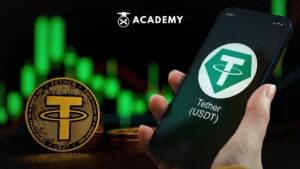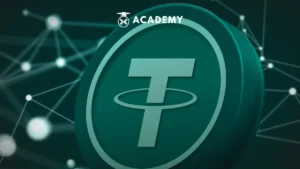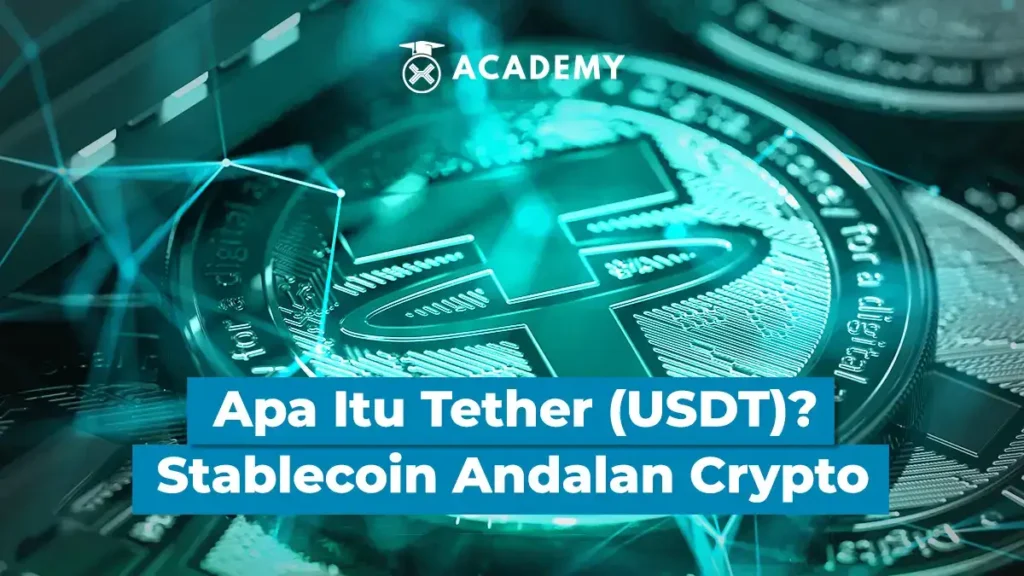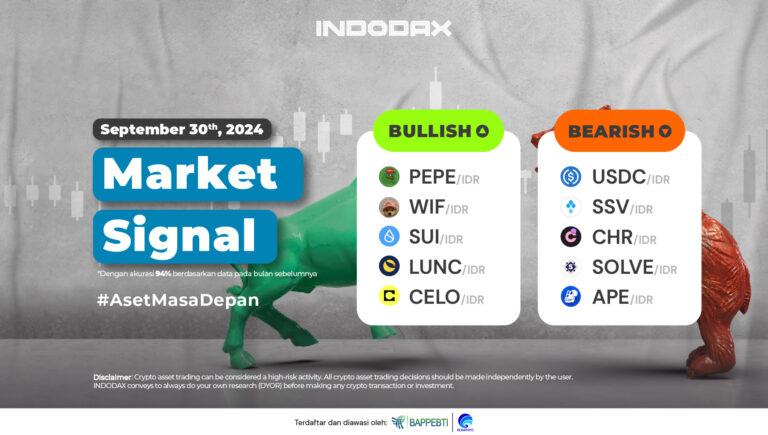In the crypto world, USDT or Tether is part of a rapidly growing type of crypto asset known as stablecoin.
This stablecoin is designed to avoid the extreme volatility that often occurs in other crypto assets by linking its value to traditional currencies such as the US dollar.
Now, to learn more about what Tether (USDT) is, starting from its history, role in the crypto world, its uses, to its advantages and disadvantages, see the full review below.

What is Tether (USDT)?
USDT or USD Tether is a crypto asset issued by Tether Limited and is a stablecoin pegged 1:1 to the US dollar (USD). Therefore, USDT offers more consistent value stability than other crypto assets.
Stablecoin itself is a type of crypto asset whose value is maintained equivalent to a certain asset, such as fiat currency or commodities such as gold.
As the first stablecoin backed by US dollar reserves, USDT was launched in 2014 and has since become the most widely used stablecoin as a trading pair on crypto exchanges worldwide.
As of March 2024, USDT is the third largest crypto asset after Bitcoin (BTC) and Ethereum (ETH),as well as the largest stablecoin, with a market capitalization of almost $99,000,000,000.
In 2023 and early 2024, Tether’s USDT accounted for the majority of trading volume on crypto asset exchanges.
Tether History: Journey and Controversy
Tether was first launched as RealCoin in July 2014 and later rebranded as Tether (USDT) in November 2014.
Originally based on the Bitcoin blockchain, Tether now supports Bitcoin’s Omni and Liquid protocols, as well as the Ethereum, Avalanche, Kava, Polkadot, TRON, EOS, Algorand, and Solana blockchains.
Tether also issues tokens pegged to the euro, offshore Chinese yuan, Mexican peso, and gold, although all of these tokens have only a fraction of the market capitalization of USDT, which is pegged to the US dollar.
In November 2017, Tether reported an electronic theft of $31,000,000 in USDT tokens. The company then performed a hard fork, a security technique that involves splitting the blockchain into two streams.
By that time, the company was already facing questions about the adequacy of its reserves, and as subsequent investigations have shown, was having difficulty accessing banking services.
Tether’s Role in the Crypto World
Tether (USDT) plays a significant role in the crypto world as the most widely used stablecoin. USDT dominates crypto trading volumes due to its ability to maintain a stable value by being pegged to the US dollar.
This stability is crucial for traders and investors who want to protect their assets from the extreme volatility that often occurs in other crypto assets, such as Bitcoin or Ethereum.
Furthermore, it is also important to note that Tether is a licensed member of the Blockchain Alliance, a coalition that works to promote blockchain development and its legal use.
Uses of Tether: More Than Just a Stablecoin
More than just a stablecoin, here are some uses of Tether (USDT) that you need to know.
1. Trading
USDT is often used in crypto asset trading activities. With USDT, traders can buy various crypto assets and also get USDT from the sale of other crypto assets.
2. International Transactions
Because its value is pegged to the US dollar, having USDT makes international transactions easier with more efficient costs and time compared to using dollars through traditional banking.
3. Collateral in DeFi
USDT also has important uses in the world of decentralized finance/DeFi. DeFi applications generally operate with crypto assets that have high volatility, which can increase the risk of loss.
As a solution, USDT can be used in on-chain form to maintain value stability. USDT can be used as collateral in DeFi, allowing users to participate more calmly amidst the price fluctuations of other crypto assets.
The advantages
The various advantages offered by Tether (USDT) have attracted many investors to invest in this stablecoin. Here are some of the advantages, namely:
- Stability: Pegged to the US dollar, USDT tends to be more stable than other crypto assets.
- High Liquidity: USDT is accepted on a variety of crypto exchanges, making it easier to buy and sell and solve liquidity issues.
- Privacy: Transactions using Tether are anonymous, providing a level of privacy not available with fiat currencies or traditional financial institutions.
- Low Fees: Sending funds through Tether’s decentralized network is faster and has lower fees.
- Wide Usage: As one of the most popular stablecoins, Tether is often used in transactions such as payments, remittances, and trading.
- Easy to Use for Beginners: Tether is extremely user-friendly, making it easy to use to send and receive payments quickly.
Disadvantages
Although it has many advantages, Tether also has a number of disadvantages, including:
- Transparency: There are concerns about the transparency of the reserves backing USDT, especially since the crypto asset has been embroiled in controversy over it.
- Centralization Risk: Tether is operated by a single entity, making it vulnerable to risks such as hacking, fraud, or government intervention.
- Market Impact: With 53% of the total stablecoin market cap, a Tether failure could have significant ramifications and potentially shake up the entire crypto market.
How Tether Maintains Price Stability
USDT or Tether was created to overcome price fluctuations that commonly occur in the crypto asset market by functioning as a stablecoin. Here are some ways USDT maintains its stability:
- 1:1 Reserve: Tether states that each USDT token is backed by one US dollar held in reserve. This means that every USDT in circulation is backed by an equivalent amount of dollars, which in theory allows users to exchange 1 USDT for 1 USD.
- Pegged to the US Dollar: USDT’s value is pegged to the US dollar. This peg is maintained through reserves held by the company and a commitment to maintain a 1:1 exchange ratio.
- Market Intervention: Tether Ltd. can intervene in the open market by buying back USDT when its price drops below the dollar, or selling USDT when its price rises above the dollar, similar to how central banks maintain the stability of fiat currencies.
- Trust in the Company: USDT’s stability is also determined by the level of trust that users and investors have in Tether Ltd. to hold the necessary reserves and keep its promise to maintain a 1:1 exchange ratio.
- Widespread Adoption: USDT’s widespread use in the crypto asset market, both as a medium of exchange and a store of value, contributes to its stability. The steady demand for its use in trading, lending, and remittances also supports its peg.
- Regulatory and Financial Oversight: Tether Ltd. states that it is transparent and undergoes audits (although the frequency and accuracy of these audits are disputed) to provide assurance that reserves exist.
Tether Supply: Is There a Limit?
It’s worth noting that USDT does not have a total supply limit because it is owned by a private company. In theory, its issuance is limited only by Tether’s internal policies.
However, because Tether claims that each USDT is backed by one US dollar, the number of tokens that can be issued depends on the company’s actual cash reserves.
Tether also does not release a token issuance schedule in advance. Instead, they provide a daily transparency report that shows their total asset and liability reserves, with these liabilities reflecting the amount of USDT in circulation.
According to Coinmarketcap, as of September 2020, there were over $14,400,000,000 USDT tokens in circulation, which Tether claims is backed by $14,600,000,000 worth of assets.
Differences between USDT and USD: Regulation and Policy
The main difference between USDT and USD lies in the regulations and policies that govern them. If USD is regulated directly by the Federal Reserve in the United States, then USDT is a crypto asset issued by a private company, Tether Limited.
In September 2017, Tether issued a memorandum from a public accounting firm stating that USDT tokens are backed by US dollar fiat money. However, Tether is not “officially” issued by a government authority.
Independent attorney Lewis Cohen emphasized that the memorandum was not enough to prove that USDT is fully backed by US dollar reserves.
USDT token holders do not have contractual rights, legal claims, or protection against losses like US dollar holders do.
Like Bitcoin and Ethereum, USDT is a crypto asset that can be used as a means of transaction to buy other coins or tokens.
Currently, USDT is one of the most frequently used trading pairs on crypto exchanges around the world, especially to buy other coins or tokens.
For example, Bitcoin paired with USDT will be displayed as BTC/USDT, while Ethereum as ETH/USDT, and so on.

What Sets USDT Apart from Other Stablecoins?
USDT is a pegged crypto asset, meaning its value only fluctuates with the value of the US dollar. Other examples of similar crypto assets include USD Coin (USDC), Binance USD (BUSD), and Dai (DAI).
One of the benefits of this pegging system is that it allows investors to easily move money between the crypto asset market and the traditional financial system. They don’t have to wait for a sharp drop in trading value.
Conclusion
Well, that was the article discussing USDT starting from the definition, history, uses, to its various advantages that you can read in full at the Crypto Academy at INDODAX Academy.
In conclusion, risk management and awareness are basically very important in trading using USDT.
Although USDT is known as a stablecoin that maintains a stable value by being pegged to the US dollar, there are still risks associated with reserve transparency, centralization, and wider fluctuations in the crypto asset market.
Therefore, traders must always be vigilant and carefully consider every step taken to protect their assets from potential losses.
The last tip that is no less important is to always do Do Your Own Research (DYOR). Before making an investment decision, it is important to understand the technical aspects, policies, and current market conditions.
With in-depth research, traders can make wiser decisions, reduce risks, and increase the chances of success in the world of crypto asset trading.
Additional Information
For additional information, INDODAX is one of the safest and most trusted crypto exchanges in Indonesia #KitayangPalingAman. INDODAX not only offers security and convenience for its users, but also upholds transparency in maintaining crypto asset reserves through Proof of Reserve.
Currently, INDODAX has strong crypto asset reserves, including 4,806.34 Bitcoin worth around IDR4.288 trillion, and 36,915.47 Ethereum worth around IDR1.334 trillion, based on the latest market price. In addition, INDODAX also holds other crypto assets worth around IDR5.907 trillion.
The total crypto asset reserves of INDODAX reach around IDR11.529 trillion, ensuring that all crypto asset reserves exceed 100% of the total balance of INDODAX members. This shows INDODAX’s commitment to Proof of Reserve, so users can be sure that their funds are safe and fully supported by real asset reserves.
FAQ
1. What is Tether (USDT)?
USDT is a stablecoin pegged to the US dollar, making it stable compared to other cryptocurrencies. Managed by Tether, USDT is used for trading, international transactions, and collateral on DeFi platforms.
2. How does Tether (USDT) maintain its price stability?
Tether maintains USDT’s stability by claiming 1:1 reserve backing against the US dollar and conducting open market operations to keep its token value in line with the US dollar.
3. What are the advantages of using Tether (USDT)?
The advantages of USDT include price stability, high liquidity, low transaction costs, and higher privacy compared to fiat currencies.
4. What are the risks and disadvantages of using USDT?
Disadvantages of USDT include questionable reserve transparency, centralization risks since it is managed by a single entity, and the potential for major repercussions if Tether fails.
5. What is Tether’s history and what are its controversies?
Tether has faced various controversies, including theft of funds, questions about its reserves, and legal fines. Despite this, Tether remains the largest stablecoin with a significant market capitalization.





 Polkadot 8.91%
Polkadot 8.91%
 BNB 0.53%
BNB 0.53%
 Solana 4.86%
Solana 4.86%
 Ethereum 2.37%
Ethereum 2.37%
 Cardano 1.18%
Cardano 1.18%
 Polygon Ecosystem Token 2.14%
Polygon Ecosystem Token 2.14%
 Tron 2.85%
Tron 2.85%
 Market
Market


